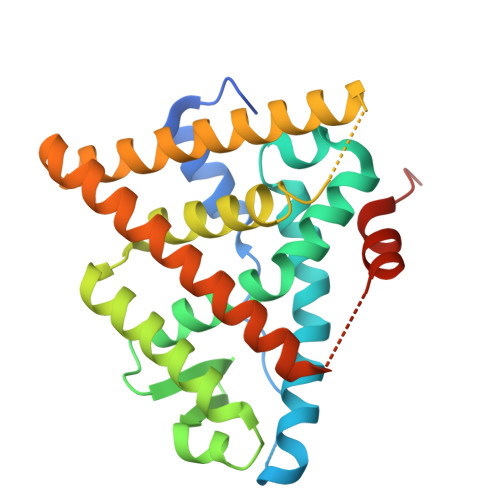Targeting unique ligand binding domain structural features downregulates DKK1 in Y537S ESR1 mutant breast cancer cells.
Young, K.S., Hancock, G.R., Fink, E.C., Zigrossi, A., Flowers, B., Cooper, D.A., Nguyen, V.T., Martinez, M.C., Mon, K.S., Bosland, M., Zak, D.R., Runde, A.P., Sharifi, M.N., Kastrati, I., Minh, D.D.L., Kregel, S., Fanning, S.W.(2025) Breast Cancer Res 27: 10-10
- PubMed: 39825366
- DOI: https://doi.org/10.1186/s13058-024-01945-z
- Primary Citation of Related Structures:
9BPX, 9BQE, 9BU1 - PubMed Abstract:
Resistance to endocrine therapies remains a major clinical hurdle in breast cancer. Mutations to estrogen receptor alpha (ERα) arise after continued therapeutic pressure. Next generation selective estrogen receptor modulators and degraders/downregulators (SERMs and SERDs) show clinical efficacy, but responses are often non-durable. A tyrosine to serine point mutation at position 537 in the ERα ligand binding domain (LBD) is among the most common and most pathogenic alteration in this setting. It enables endocrine therapy resistance by superceding intrinsic structural-energetic gatekeepers of ER hormone-dependence, it enhances metastatic burden by enabling neomorphic ER-dependent transcriptional programs, and it resists SERM and SERD inhibiton by reducing their binding affinities and abilities to antagonize transcriptional coregulator binding. However, a subset of SERMs and SERDs can achieve efficacy by adopting poses that force the mutation to engage in a new interaction that favors the therapeutic receptor antagonist conformation. We previously described a chemically unconventional SERM, T6I-29, that demonstrates significant anti-proliferative activities in Y537S ERα breast cancer cells. Here, we use a comprehensive suite of structural-biochemical, in vitro, and in vivo approaches to better T6I-29's activities in breast cancer cells harboring Y537S ERα. RNA sequencing in cells treated with T6I-29 reveals a neomorphic downregulation of DKK1, a secreted glycoprotein known to play oncogenic roles in other cancers. Importantly, we find that DKK1 is significantly enriched in ER + breast cancer plasma compared to healthy controls. This study shows how new SERMs and SERDs can identify new therapeutic pathways in endocrine-resistant ER + breast cancers.
- Department of Cancer Biology, Loyola University Chicago Stritch School of Medicine, Maywood, IL, 50153, USA.
Organizational Affiliation:

















